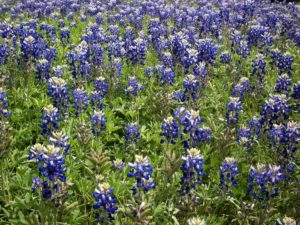Springtime means many things—thoughts turning to love, spring break vacations, spring cleanings, and the like.
In Texas, springtime also means going out to see the bluebonnets blooming in the countryside. They’re lovely to look at and are unique to Texas.
Bluebonnets blossom all around Texas. For many, a favorite place to go see them and take pictures would be along U.S. 290 between Houston and Brenham, or in and near the towns nearby, such as Chappell Hill, Hempstead, Navasota, and Round Top.
1. There are five types of bluebonnets.
When the Texas Legislature selected the bluebonnet as the state flower in March 1901, the Lupinus subcarnosus was the flower people had in mind. But other variations of the bluebonnet existed, and ultimately, in 1971, Texas recognized all five variations.
According to an article by Jerry M. Parsons, Steve George, and Greg Grant of the Texas Cooperative Extension, the five state flowers of Texas are:
- Lupinus subcarnosus, the original champion and still co-holder of the title, grows naturally in deep sandy loams from Leon County southwest to LaSalle County and down to the northern part of Hidalgo County in the Valley. It is often referred to as the sandy land bluebonnet. The plant’s leaflets are blunt, sometimes notched with silky undersides. This species, which reaches peak bloom in late March, is not easy to maintain in clay soils.
- Lupinus texensis, the favorite of tourists and artists, provides the blue spring carpet of Central Texas. It is widely known as THE Texas bluebonnet. It has pointed leaflets, the flowering stalk is tipped with white (like a bunny’s tail) and hits its peak bloom in late March and early April. It is the easiest of all the species to grow.
- Lupinus Havardii, also known as the Big Bend or Chisos Bluebonnet, is the most majestic of the Texas bluebonnet tribe with flowering spikes up to three feet. It is found on the flats of the Big Bend country in early spring, usually has seven leaflets and is difficult to cultivate outside its natural habitat.
- Lupinus concinnus is an inconspicuous little lupine, from 2 to 7 inches, with flowers which combine elements of white, rosy purple and lavender. Commonly known as the annual lupine, it is found sparingly in the Trans-Pecos region, blooming in early spring.
- Lupinus plattensis sneaks down from the north into the Texas Panhandle’s sandy dunes. It is the only perennial species in the state and grows to about two feet tall. It normally blooms in mid to late spring and is also known as the dune bluebonnet, the plains bluebonnet and the Nebraska Lupine.
Recognition also was extended to other variations not yet discovered that were part of the species.
2. Not all bluebonnets are blue.
According to Parsons, George, and Grant, Texas Cooperative Extension horticulturists have worked to create white and pink bluebonnets. Other bluebonnets come in different colors, but were not genetically developed by horticulturists.
A bluebonnet of another color is still a bluebonnet. It would just be called a white bluebonnet, a pink bluebonnet, or whatever color it might be.
3. Plant bluebonnets in September or October, not in the spring.
If you made the drive to the nearest field with bluebonnets, you might think they were planted only a few weeks previously. Not true.
According to Parsons, George, and Grant, the time to plant bluebonnets is early in the fall, such as in September or October. This is because a bluebonnet seed has a hard coat that needs penetration by winds and rain for an extended period of time—usually a few months.
4. The bluebonnet beat out the prickly pear cactus as the Texas state flower.
The Texas Legislature voted to make the bluebonnet the Texas state flower in 1901. But not everyone was happy with the decision. One state representative, John Nance Garner, argued in favor of the prickly pear cactus. He lost the vote, but got a nickname (“Cactus Jack”) and would go on to serve as vice president of the United States from 1933-1941.

